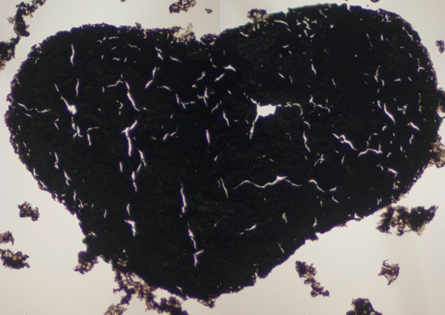Tiny fossils a billion years old — the earliest ones yet found of complex cells outside the sea — give the first direct evidence that evolution in freshwater had already expanded beyond bacteria long before the first trilobite skittered through Paleozoic muck.

Fossilized bits less than a millimeter long from Scotland suggest that cells with nuclei were flourishing beyond the oceans, says Paul K. Strother of Boston College. Such cells distinguish one of the three major domains of life, the eukaryotes, which today range from elaborate microbes such as the schoolbook paramecium to all plants, fungi and animals.
The fossilized cells or masses of cells look eukaryotic because of features not known from bacteria, Strother and his colleagues report online April 13 in Nature.
For example, one fossil appears to be a mass with three lobes. Other finds show evidence of cell coverings splitting along a preformed biological zipper, or cells with protective coverings bearing complex patterns.
Equally complicated eurkaryotes had arisen in the seas a billion years ago. But fossil eukaryotes from freshwater mean that “our models of how life evolved on this planet should no longer just include the idea that everything was floating around in the ocean.” Strother says. “We really have to consider the [nonmarine] environments as a cradle of evolution.”
These freshwater eukaryote fossils are the earliest by a lot, says paleontologist Susannah Porter of the University of California, Santa Barbara, who mused about which example from 500 million years later would count as the runner-up. In Strother’s find, she says, “It’s exciting to see the cast of characters and to see they are pretty diverse and, in some cases, pretty complex.”
Some of these fossils had been sitting for decades on prepared slides at the University of Sheffield in England. Earlier interpretations dismissed them as more bacteria, Strother says. Inspired by the slides, he and his colleagues returned to the swath of ancient rock where the fossils were found along the northwest coast of Scotland, called the Torridonian, to collect more samples.
Some of the microfossils may even have survived exposure to air, Strother says. The rock shows signs of drying out, such as patterns of cracks and raindrop divots. And what look like fossilized protective cysts for cells may have allowed early experiments with terrestrial life. Bacterial mats had colonized land by a billion years ago, but what else might have lived there remains a matter of debate.
The Torridonian find stirred enthusiasm from researchers working with other lines of evidence suggesting that life outside the seas was doing fancy stuff back in this time. “I love it,” says evolutionary biologist Blair Hedges of Penn State University in University Park. Looking at rates of change in DNA in family trees of organisms, what’s called molecular clock data, convinced him at least a decade ago that early forms of fungi and plants were colonizing the supposedly rocky wasteland of terrestrial environments long before the traditionally recognized explosion of life-forms half a billion years ago.
Paul Knauth of Arizona State University in Tempe has used biogeochemical data to argue that something besides bacteria was growing on land. He points to arguments that oceans were much more saline in this time. “It is possible that most Precambrian evolution of life was actually going on in the nonmarine — lakes, rivers, streams, soils,” he says. Exploring nonmarine deposits from this time, he adds, “is the new frontier.”






